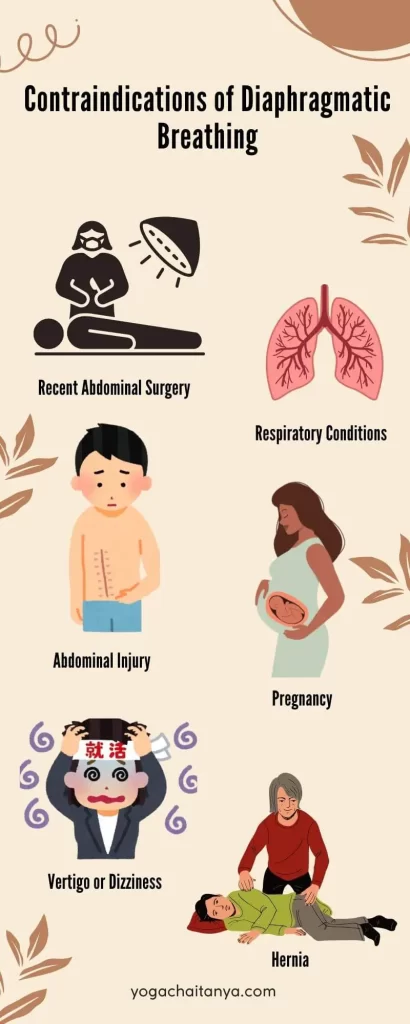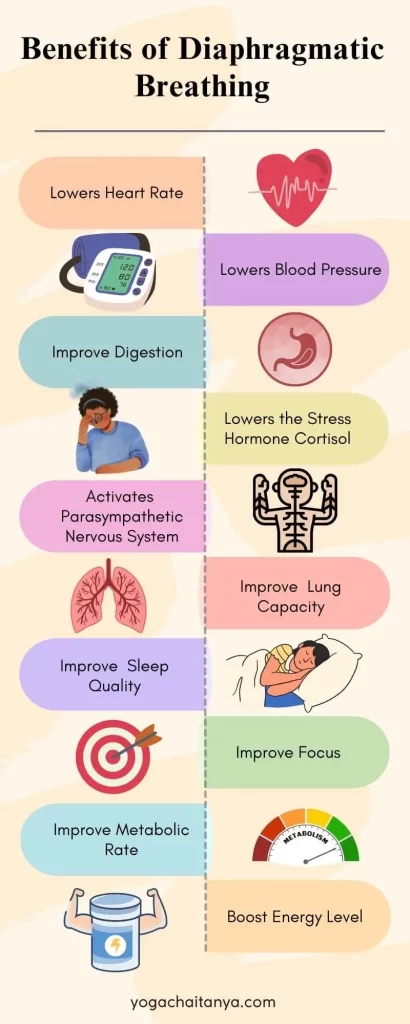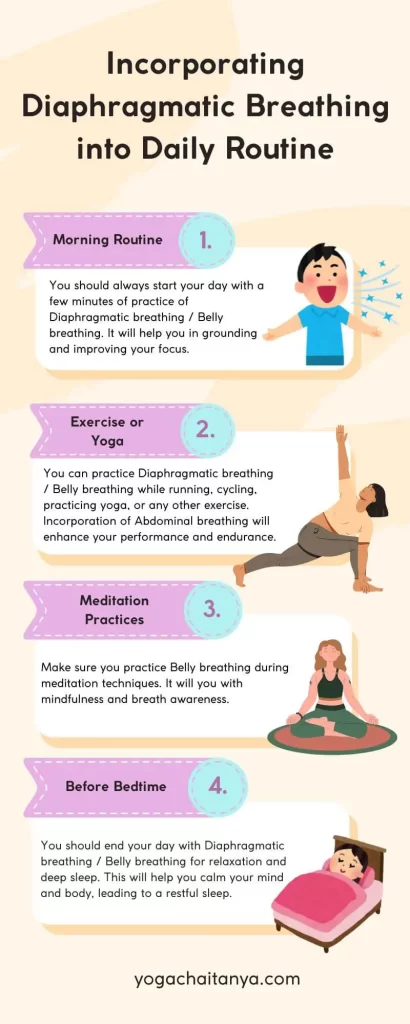Ultimate Guide to Diaphragmatic Breathing: Path to Wellness !
-
Written By: Sukhvinder Singh (Chaitanya)
- Published On:
- Last Updated: December 5, 2024
If you master a simple breathing technique then it can completely transform your physical and mental wellbeing. Can you believe it?
Yes, there is a breathing technique and it is known as Diaphragmatic Breathing, Abdominal Breathing, or Belly Breathing.
This is the most comprehensive guide to Diaphragmatic Breathing, Abdominal Breathing, or Belly Breathing ever. In this guide, you will learn everything you need to know about the practice and implementation of Diaphragmatic Breathing / Belly Breathing in daily life.
By regular practice of Diaphragmatic Breathing, many people have healed their physical, mental, and emotional problems. Diaphragmatic Breathing will help you enhance the quality of your life.
As a beginner or an advanced yoga practitioner, you may have questions or difficulties implementing Diaphragmatic Breathing /Abdominal Breathing. This Ultimate Guide to Diaphragmatic Breathing: Path to Wellness will provide you with in-depth knowledge of the topic. Here you will learn:
- Introduction to Diaphragmatic Breathing
- The Physiology Behind Diaphragmatic Breathing / Abdominal Breathing.
- How Diaphragmatic Breathing Works
- Significance of Diaphragmatic Breathing or Belly Breathing
- Why you should do Abdominal Breathing?
- How to Practice Diaphragmatic Breathing / Abdominal Breathing?
- How to do Belly Breathing?
- Common Mistakes to Avoid during Diaphragmatic Breathing
- Contraindications of Diaphragmatic Breathing / Belly Breathing
- What are the Benefits of Diaphragmatic Breathing/ Belly Breathing?
- Scientific Research and Studies on Diaphragmatic Breathing/ Belly Breathing / Abdominal Breathing.
- Incorporating Diaphragmatic Breathing/ Belly Breathing into Daily Routine
- Common Challenges and Solutions for Diaphragmatic Breathing
Table of Contents
Introduction to Diaphragmatic Breathing
Diaphragmatic Breathing is also known as Abdominal breathing or Belly Breathing. The diaphragmatic breathing technique involves the conscious use of the diaphragm. During inhalations the the abdomen expands, whereas during exhalation the abdomen contracts.
Physiology Behind Diaphragmatic Breathing / Belly Breathing
In our human body, the diaphragm is a dome-shaped muscle located below the lungs. It plays a crucial role in belly breathing / abdominal breathing. When you inhale, the diaphragm contracts and moves downward, to create the space for the lungs to expand. As you exhale, the diaphragm relaxes, allowing the lungs to deflate and air to expel.
Understanding Diaphragmatic Breathing
How Abdominal Breathing or Belly Breathing Works
In normal breathing or deep breathing when you inhale the diaphragm moves down. The abdomen expands and the air enters the lower lobes of the lungs. And then muscles of the chest i.e. the intercostal muscle contract expanding the rib cage.
This creates a negative pressure in the lungs and air moves into the middle lobes of the lungs. If you will further use the muscles of the upper chest, neck, and shoulders. Then the air moves into the upper lobes of the lungs.
On exhalation, the muscles of the upper chest and middle chest relax, and the air is pushed out of the lungs. If you will exhale deeply then the abdomen will contract to move the diaphragm up. And, the air is pushed out of the lower lobes of the lungs.
Whereas in Diaphragmatic Breathing or Belly Breathing when you inhale through your nose, the diaphragm contracts and moves downwards. This creates space in the chest cavity for the lungs to expand. Further, allows air to flow into the lungs, filling them from the bottom up. As you exhale, the diaphragm relaxes, pushing air out of the lungs.
Significance of Diaphragmatic Breathing or Belly Breathing
Why you should do Abdominal Breathing?
The diaphragm separates the lungs from the abdominal cavity. In normal chest breathing, it hardly moves. But during deep breathing, the diaphragm moves downward into the abdomen. Whereas on exhalation, the diaphragm moves upward promoting the most efficient type of breathing.
If you will watch Infants and small children they use their diaphragms for breathing. Chest breathing occurs later after the development of the bony structure of the chest.
Diaphragmatic breathing / Abdominal breathing or Belly breathing should be practiced during daily life until it becomes a habit.
Diaphragmatic breathing is particularly recommended for those suffering from chronic lung and heart disease. It is the simplest way to relax any mental tension. Since, it promotes parasympathetic and cardiovascular dominance.
You will be amazed to know that some of the armed forces across the world teach box breathing and Diaphragmatic breathing to handle stress during military operations.
How to Practice Diaphragmatic Breathing / Abdominal Breathing?
How to do Belly Breathing?
For practicing Diaphragmatic Breathing or Abdominal breathing sit in any comfortable posture with a straight spine. You can also do it on the chair. Diaphragmatic Breathing or Abdominal breathing can be practiced while lying down in Shavasana. Choose whichever is comfortable for you.
To begin Diaphragmatic Breathing first bring your awareness to your breath and just watch your breath going in coming out.
- Do not try to manipulate or alter your breathing pattern.
- Just observe your breath going in and coming out.
- Be completely aware of your breath.
- Just come in this present moment… Here and Now!
- Practice this for 2-3 Minutes.
Now bring your awareness to your abdomen. Now, as you inhale expand your abdomen like a balloon. As you exhale contract your abdomen moving the navel in towards your spine.
Inhale expand your abdomen, as you exhale contract the abdomen bringing the navel in toward the spine.
Practice three to seven rounds at your own pace and comfort. This is Diaphragmatic Breathing / Abdominal Breathing or Belly Breathing.
Tips for Beginners for Diaphragmatic Breathing
If you’re new to Diaphragmatic Breathing / Belly Breathing, start by practicing for just a few minutes each day. Gradually increase the duration as you become more comfortable with the technique. Be patient with yourself and allow your body to adapt to the new breathing pattern.
You can lie down in Shavasana and keep a foam yoga block (Lightweight) on your abdomen. Now practice Diaphragmatic Breathing / Belly Breathing with the yoga block on the abdomen. This will help you keep your awareness on the abdomen allowing rhythmic movement of breath and diaphragm.
Common Mistakes to Avoid during Diaphragmatic Breathing
- Poor posture : Make sure your spine is straight and you maintain a good posture while doing Abdominal breathing / Diaphragmatic Breathing. Ensure your shoulders are relaxed. This will prevent unnecessary strain on the neck and back. Further, it allows optimal airflow and helps the abdomen to expand and contract easily during Diaphragmatic Breathing.
- Shallow Breathing: Do not practice shallow breathing, this will limit the benefits of Belly breathing / Diaphragmatic breathing. Further, it can lead to tension and stress. Make sure you fully engage your diaphragm while expanding and contracting the abdomen during each breath.
- Overexertion of Abdominal Muscles: While practicing Diaphragmatic Breathing engagement of the abdominal muscles plays an important role. Yet as per my observation, while teaching Diaphragmatic Breathing, I have seen many students applying excessive tension or strain on abdomen muscles. Keep your abdomen relaxed and let the diaphragm move naturally, rather than forcing the movement with your muscles.
Contraindications of Diaphragmatic Breathing / Belly Breathing
Abdominal breathing, also known as diaphragmatic breathing, is safe. However, there are certain contraindications or situations where Diaphragmatic Breathing / Belly Breathing should be avoided or used with caution:
Recent Abdominal Surgery: If you have undergone recent abdominal surgery then you should consult your doctor before practicing Diaphragmatic Breathing / Belly Breathing, since it may put strain on the abdominal region.
Respiratory Conditions: If you are struggling with certain respiratory conditions such as chronic obstructive pulmonary disease (COPD), or severe asthma, then you may experience slight discomfort with abdominal breathing. You should consult your doctor before practicing Diaphragmatic Breathing / Belly Breathing techniques.
Abdominal Injury: If you have a recent abdominal injury or trauma, then you should avoid deep Diaphragmatic Breathing / Belly Breathing until you fully recover from the issue.
Pregnancy: If you are a Pregnant woman in the later stages of pregnancy then you should consult your doctor before practicing Diaphragmatic Breathing / Belly Breathing. It may affect the position of the fetus in your womb and cause discomfort.
Hernia: If you have an abdominal hernia then you should be cautious with Diaphragmatic Breathing / Belly Breathing, since it may exacerbate the hernia or cause discomfort.
Vertigo or Dizziness: If you experience dizziness or vertigo while practicing Diaphragmatic Breathing / Belly Breathing, then discontinue the practice and consult a healthcare professional.

Benefits of Diaphragmatic Breathing or Abdominal Breathing
What are the Benefits of Belly Breathing?
1) The regular practice of Diaphragmatic Breathing / Belly Breathing engages the diaphragm. This helps to strengthen the diaphragm.
2) Diaphragmatic Breathing / Belly breathing slows down the breathing rate. Further, it helps to lower the heart rate and blood pressure. So if you are suffering from heart disease and hypertension. Then you must practice Diaphragmatic Breathing / Belly breathing.
3) The movement of the diaphragm during belly breathing massages the internal organs. Further, it helps to tone the muscles of the abdominal walls. It will improve your digestion, metabolic rate, and excretory functions.
4) Regular practice of Diaphragmatic Breathing / Abdominal Breathing will help you improve the stability of your core muscles.
5) Diaphragmatic Breathing / Abdominal Breathing promotes relaxation. It will lower the stress hormone cortisol in your body. So in case of anxiety and panic, you can practice Diaphragmatic Breathing /Belly Breathing.
6) The Practice of Abdominal Breathing or Diaphragmatic breathing activates the parasympathetic nervous system. Further, it massages and tones the vagus nerve. The vagus nerve is a parasympathetic nerve, that connects the abdominal organs, heart, and lungs to the brain.
7) Diaphragmatic breathing will help you maximize your lung capacity. Further, it will ensure optimal oxygen exchange in the body. This can boost your energy levels, enhance mental clarity, and support overall well-being.
8) You can practice Diaphragmatic breathing/ Abdominal breathing at your bedtime routine. It will help to improve your sleep quality. It will slow down your thoughts and brain wave patterns, which will help you fall asleep easily.
9) Diaphragmatic breathing / Belly breathing will help you increase your focus and productivity. When you are facing a demanding task or project, or when you are in tension try it.

Research and Studies on Diaphragmatic Breathing
Numerous studies have been conducted to study the efficacy of Diaphragmatic breathing for reducing stress, improving respiratory function. And enhancing overall well-being. Different research papers suggest that regular practice of Diaphragmatic breathing / Abdominal breathing has long-term benefits for cardiovascular health and immune function. Let us dive into some of the research studies:
Reduction of Stress and Anxiety: A study published by Research Gate: “The Effect of Diaphragmatic Breathing on Attention, Negative Affect, and Stress in Healthy Adults” demonstrated the effect of diaphragmatic breathing.
This study aimed to investigate the effect of diaphragmatic breathing on cognition, affect, and cortisol responses to stress. Forty participants were randomly divided into two groups. They were assigned to either a breathing intervention group (BIG) or a control group (CG).
Results: The group practicing diaphragmatic breathing (BIG) had a significantly lower cortisol level after training, while the control group showed no significant change in cortisol levels.
In conclusion, diaphragmatic breathing could improve sustained attention, affect, and cortisol levels. This study provided evidence demonstrating the effect of diaphragmatic breathing, a mind-body practice, on mental function, from a health psychology approach, which has important implications for health promotion in healthy individuals.
Lowering Blood Pressure: A study published in Science Direct: “Effects of diaphragmatic deep breathing exercises on prehypertensive or hypertensive adults” explained the effect of diaphragmatic breathing.
This study concluded that diaphragmatic deep breathing could significantly improve autonomic dysfunction in patients with prehypertension and hypertension by lowering blood pressure and heart rate. Such a breathing technique may produce a beneficial psychological effect on prehypertensive and hypertensive adults.
Incorporating Diaphragmatic Breathing into Daily Routine
Here are some practical tips that will help you integrate Diaphragmatic Breathing into your life:
Morning routine: You should always start your day with a few minutes of practice of Diaphragmatic breathing / Belly breathing. It will help you in grounding and improving your focus. This will prepare you for the day ahead and help you tackle your daily tasks.
Using During Exercise or Yoga: You can practice Diaphragmatic breathing / Belly breathing while running, cycling, practicing yoga, or any other exercise. Incorporation of Abdominal breathing will enhance your performance and endurance.
Integration into Meditation Practices: Make sure you practice Belly breathing / Abdominal breathing during meditation techniques. It will you with mindfulness and breath awareness.
Before bedtime: You should end your day with Diaphragmatic breathing / Belly breathing for relaxation and deep sleep. This will help you calm your mind and body, leading to a restful sleep.

Common Challenges and Solutions for Diaphragmatic Breathing
Diaphragmatic breathing / Belly breathing / Abdominal breathing is quite simple to learn. However, some people can encounter challenges along the way.
Overcoming Initial Difficulties: If you are a beginner then you may struggle with coordinating your breath with your diaphragm movement. Don’t worry, it may take some time. Be patient and be gentle with yourself as you develop this skill.
Maintaining Consistency: Consistency is key. Make sure you are consistent with the practice of Diaphragmatic breathing / Abdominal breathing if you want to get the maximum benefits. You should set realistic goals for your practice and try to incorporate breathing exercises into your daily routine.
Seeking Instruction and Support: You can attend a few meditation or yoga classes led by a qualified instructor. They will guide you through proper breathing techniques. Additionally, you can also refer to online tutorials on YouTube, books, and apps dedicated to teaching breathing practices.
Frequently Asked Questions about Diaphragmatic Breathing
Can anyone practice Diaphragmatic Breathing / Abdominal breathing / Belly Breathing?
Yes, anyone can practice Diaphragmatic Breathing/ Abdominal breathing/ Belly Breathing. Diaphragmatic Breathing can be practiced by individuals of all ages and fitness levels.
How often should I practice Diaphragmatic Breathing / Abdominal breathing / Belly Breathing?
You should practice abdominal breathing/belly breathing for at least 5-10 minutes every day to experience its benefits. Make sure you incorporate it into your daily routine.
Can Diaphragmatic Breathing / Belly Breathing help with anxiety?
Yes, you can practice Diaphragmatic Breathing / Belly Breathing for managing anxiety and reducing panic attacks. It activates the relaxation response, that will help calm your mind and body.
Is Diaphragmatic Breathing/ Abdominal Breathing / Belly Breathing the same as meditation?
No, Diaphragmatic Breathing is different from meditation. You can incorporate abdominal breathing/belly breathing during meditation practices. Abdominal breathing can be used as a standalone technique for relaxation and stress relief, whereas meditation encompasses a broader range of practices aimed at cultivating mindfulness and awareness.
Can Diaphragmatic Breathing/ Abdominal Breathing/ Belly Breathing improve sleep quality?
Yes, the practice of belly breathing promotes relaxation, and ease at bedtime. It can help you transition into sleep. It will calm your mind and body, further reducing your racing thoughts.
How long does it take to experience the benefits of Diaphragmatic Breathing/ Abdominal breathing/ Belly Breathing?
In some cases, you may experience immediate improvements in mental state, mood, etc after a few minutes of practice of Diaphragmatic Breathing. If you have chronic issues then it may take a few months of practice to see significant changes. Consistency is key—make sure you are doing abdominal breathing every day.
Can Diaphragmatic Breathing/ Abdominal breathing help with chronic respiratory conditions such as asthma or COPD?
Yes, the practice of Diaphragmatic Breathing/ Abdominal breathing can help with chronic respiratory conditions such as asthma or COPD. But it is not a cure for these conditions. It will help you manage some symptoms and improve your overall lung function. Always consult with your healthcare professional for personalized advice and treatment.
Is Diaphragmatic Breathing / Abdominal Breathing / Belly Breathing the same as deep breathing?
No, Diaphragmatic Breathing / Abdominal Breathing is different from Deep breathing. In abdominal breathing or belly breathing, we utilize the lower and middle lobes of the lung. Whereas in Deep breathing or Yogic breathing, we utilize full lung capacity. Deep breathing or Yogic breathing is the combination of Belly Breathing, chest breathing, and clavicular breathing.
Are there any contraindications or risks associated with Diaphragmatic Breathing / Abdominal Breathing / Belly Breathing?
Diaphragmatic Breathing / Abdominal Breathing / Belly Breathing is safe for most people and you can practice it. However, if you have certain medical conditions or injuries consult a doctor before doing it. If you had recent abdominal surgery, abdominal injury, hernia, or pregnancy always consult your doctor.
Can Diaphragmatic Breathing / Abdominal Breathing / Belly Breathing help with digestive issues?
Yes, Abdominal breathing or Belly breathing will help improve digestive issues. During Belly breathing / Abdominal breathing, the up and down moment of the diaphragm massages the internal organs. It promotes the relaxation of the abdominal muscles and improves blood flow to the digestive organs. This further alleviates symptoms of indigestion, bloating, and discomfort.
When is the best time to practice Diaphragmatic Breathing / Abdominal Breathing / Belly Breathing?
You can practice Diaphragmatic Breathing / Abdominal Breathing / Belly Breathing anytime, anywhere. Whenever you are free, or the moment you can move your awareness on the breath, start practicing belly breathing. You can also incorporate it into your morning or bedtime routines. During exercise, yoga, meditation, or moments of stress or tension throughout the day.
Can children benefit from Diaphragmatic Breathing / Abdominal Breathing?
Yes, children will also get benefits from the practice of Abdominal breathing / Diaphragmatic Breathing. But if you will closely monitor the breathing of children, you will find that are already doing Abdominal Breathing / Belly Breathing. This is the reason children have a lot of energy, they are fresh and stress-free.
Conclusion
Diaphragmatic Breathing / Belly Breathing / Abdominal breathing is a simple yet powerful breathing practice. It will enhance each aspect of your life. By mastering this breathing technique, you can tap into peace, vitality, and resilience.
If you’re looking to reduce stress, improve your health, or deepen your spiritual practice, then try incorporating Diaphragmatic Breathing into your daily practice and see the results.
I hope you liked this post. Now I would like to hear from you. What did you think of today’s post?
Or maybe if you have a question about Diaphragmatic Breathing / Belly Breathing. Let me know by leaving a comment below.
Practice abdominal breathing regularly to stay calm and disease free. Also learn different types of breathing practices in upcoming 200 hour Yoga Teacher Training India.
Become A Certified 200 Hours Yoga Teacher. Join one of the best 200 hour yoga teacher training in India and transform your life. Learn the skills and art of teaching yoga with confidence from experienced yoga teachers. Its a unique opportunity for self-discovery, and personal growth. Book Now!
Start your Yoga Journey to Transform your Life !

About the Author: Sukhvinder Singh Chaitanya
Sukhvinder Singh (Chaitanya) is an experienced yoga teacher. (ERYT-500 & YACEP with 20,000+ hours of teaching experience) He is a master yoga teacher in Ashtanga Vinyasa Yoga, Vinyasa Flow, Hatha Yoga, Yin Yoga, Iyengar Yoga, Ayurveda & Laughter Yoga. He has been teaching yoga, laughter yoga & meditation all across the globe in teacher training programs, workshops & corporate sector for almost 10 years. He's the founder and director of the Yoga Chaitanya International Institute, a leading Yoga Teacher Training school in the world. He shares his expertise in his blogs and his YouTube Channels.
